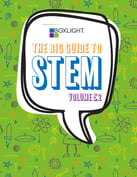
Today’s educators know how vital STEM fields are for their students. STEM learning covers a multitude of necessary skills: hands-on, critical thinking, problem solving, student-driven, creativity, innovation, collaboration, inquiry, leadership, and teamwork. These skills will help today’s students excel in STEM careers, which are growing at a rate of 17%—compared to 9.8% in other professions.
Robotics and coding are becoming more and more popular for incorporating STEM in the classroom. Both activities are engaging for students while providing the ability to apply their knowledge of science, mathematics, and technology to solve problems.
Interesting in incorporating these activities into your classroom? Here are our top picks for robotics and coding resources:
- Hopscotch: Designed for ages 8–11 and excellent for beginner programmers, Hopscotch is a free iPad app that uses video tutorials to teach students how to code popular games. Kids can then play games created by other users with the app. There are also resources for educators, such as lesson plans and transition guides.
- Kodable: This program provides a tool for coding in the classroom with over 49 free levels of exploring. It is recommended for ages five and over, and is both iPad and web-based. Their comprehensive curriculum focuses on group and independent practice activities that build creativity, collaboration, and communication.
- Code.org: If you are looking to integrate coding in the classroom, Code.org provides courses built off curriculum that contain lesson plans, handouts, offline activities, videos, and online tutorials. Using a teacher dashboard, lesson activities can be assigned, activities can be monitored, and sharing permissions can be set. The activities provide a mix of online independent practice, discussions, and unplugged group activities. The Computer Science Fundamentals courses provide educators with many options to use with students and are designed to be flexible. Plus, they provide Hour of Code tutorials for beginner coders.
- Scratch: This project from MIT’s Lifelong Kindergarten Group teaches math, programming, and creative expression through technology. Students can create animations, games, and models that communicate artistry and learning. The application is split into three sections on the screen. In the middle, students can see available drag-and-drop programming blocks. On the right, students can program and edit the appearance of various sprites (characters) that the program provides or use one of their own. On the left, students can see their coding work in action. Scratch meetups are hosted in many different states and provide opportunities for Scratch educators to meet and share ideas and resources. Check out Scratch Day, a yearly gathering of students, parents, and teachers to share Scratch ideas and participate in various activities.
- Google CS First: This site provides students aged 9–14 with activities that introduce computer science and programming through Scratch. Different themes such as animation, sports, game design, storytelling, and art engage students with video tutorials and practice. Each theme includes eight activities and about 10 hours of content that can be spread out over several days or weeks. It is ideal for computer clubs and/or courses. They also offer various Hour of Code activities such as Create Your Own Google Logo, Animate a Name, and High Seas Activity. CS First earned an ISTE Seal of Alignment for addressing the ISTE Standards for Students.
- Wonder Workshop Dash/Dot Robots: Dash and Dot for ages 6–11 are a pair of robots from Wonder Workshop with five accompanying apps that help kids program the robots. Blockly introduces students to coding using visual blocks of code. Though the apps are free, the robots must be purchased either individually or as a package deal, with various accessories for each. In Blockly, students work through a hands-on tutorial and then can complete puzzles where they have to write the prescribed programs. They can also create their own programs, including custom sounds, and save them in the app. The robots will need to be detected via Bluetooth by the app each time they play. Cue robots are designed for students aged 11+.
- Mimio MyBot educational robotics system: The robotic opportunities are endless with the Mimio MyBot system. Students can build a variety of robots, connect them to a browser, and code with a simple drag-and-drop interface. Educators have access to on-device materials such as tutorials, videos, user guides, and programming guides.
- Machine Learning for Kids: Find projects to introduce students to the concepts of machine learning and artificial intelligence using the Scratch block-based coding language and MIT App Inventor. Users sign up for a free account from IBM Cloud to get access to Watson, the question-answering computer system. Machine Learning for Kids provides step-by-step instructional guides for creating various data sets to train the AI. Students can then see the machine learning in action as it runs through the Scratch interface.
- Tynker games: Teach your elementary students coding concepts with a focus on activities for grades K-8. Tynker has a comprehensive curriculum, STEM courses, and classroom management tool built right in. They also offer free training for schools.
- Unplugged coding activities: These do not require the use of a computer and are a great way of introducing coding concepts before students use the computer. Codespark Academy provides various unplugged activities such as Make Your Own Foo and Design a Comic—these activities are provided to educators with a free account. CS Unplugged is a collection of free learning activities that teach computer science through engaging games and puzzles that use cards, string, crayons, and student movement.
Need some assistance bringing robotics and coding to your classroom? Consider using DonorsChoose.org or find other creative ways through social media to acquire funds for your program. To read more about robotics, coding, and STEM learning, be sure to download our new and improved STEM guide. In this guide, you'll find best practices to engage students in STEM subjects, updated top 10 STEM resource lists, a how-to guide for creating hands-on STEM lessons, and much more. Download your free guide today!




